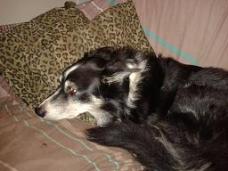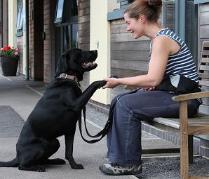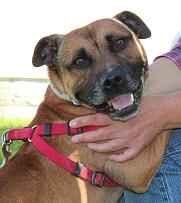Advice section
This section gives advice for you to follow, should you see signs of anxiety or fear in your dog:
Follow the links to the relevant section:
-
What do I do when I see any of the behavioural signs of anxiety and fear?
-
Why should I seek advice for my dog showing signs or anxiety or fear?
-
Who do I seek advice from?
What do I do when I see any of the behavioural signs of anxiety and fear? 
Immediate response:
Remove your dog: As soon as your dog shows the behavioural signs you have noted, remove him from the situation. For example, this may involve asking other people to move away, taking him off a street with noisy traffic, or stopping grooming him. In situations where you cannot get away (e.g. loud noises occurring in your home), stay as calm as possible yourself, make sure he has somewhere safe to hide (e.g. make a ‘den’ for him in a under stairs cupboard), and do not try and interact with him.
Record what happened: note what was happening when the behaviour occurred, and what happened directly before. Write down as much detail as possible about the situation. Note if this is a NEW behaviour for your dog, behaviour happening in a NEW SITUATION, or a behaviour shown previously. This information will be useful if you seek advice from a behaviourist.
Avoid: In order to change how your dog reacts to these events, you will need to avoid them in the short term. This is because it will make it difficult for your dog to learn a different response to these events if he continues to experience them at such a level that he shows signs associated with anxiety or fear. To teach him a different response, a behaviourist will devise a programme where he will experience the things he reacts to in a very controlled manner. Coming across these things in an uncontrolled way will make this process much more difficult. Check the notes that you have made about the situation(s) that your dog is reacting to. Use these to work out how you can alter your routines or activities to make sure that he is unlikely to experience these in his day to day life, until you get further help. If you cannot identify how to avoid these events, or it is not practical to do so, get in touch with a behaviourist straight away who will be able to help you with this ‘first aid’ advice.
Seek advice: details of who to contact to seek advice are available below.
 Why should I seek advice for my dog showing signs or anxiety or fear?
Why should I seek advice for my dog showing signs or anxiety or fear?
Even if the signs that you see don’t seem very serious, or are not causing you a problem, it is important to seek help from a professional as soon as possible. This is because dogs will often react more and more to things that they are worried about, and he may well end up with a behaviour that is a problem for you (such as aggression) if you don’t act straight away. It is also easier to change how a dog responds if remedial work is done in the early stages rather than leaving it until it is more serious. This means that it will be easier for you to address his behaviour the earlier that you seek help, and the behaviour will be more likely to be successfully changed. Seeking help is also important for his welfare – recognising that he is anxious or fearful and addressing this as soon as possible is important for his quality of life, as well as the relationship between you.
Who do I seek advice from?
First you should contact your veterinary surgeon. This is important because many behavioural changes in dogs can be associated with medical conditions or diseases, and it is important to investigate this possibility first. Your vet will examine your dog, and may need to do further examinations or tests to make sure there is no medical cause for the behaviour. The vet may decide that you should be referred to other specialists to treat the dog. This may include a behaviour practitioner.
Once you have established that there are no medical causes, you will need to seek the help of a professional behaviour practitioner. This is someone who has had both training and experience in dealing with undesired behaviours in animals, and will be able to identify why your dog is reacting as he/she is, and develop a tailored programme to change its behaviour. They will also have an up-to-date understanding of the science behind clinical practice and use welfare compatible methods of re-training. This will be either a veterinary behaviourist or a clinical animal behaviourist.
There are many different types of qualifications in animal behaviour. You can find out more information about the different types of practitioners working in animal behaviour and training from the Animal Behaviour and Training Council. For more information go to: www.abtcouncil.org.uk.
Veterinary behaviourists
Veterinary surgeons with particular expertise in behavioural medicine are recognised by the European College of Animal Welfare and Behavioural Medicine (www.ecvbm.org) and / or as a Recognised Specialist by the Royal College of Veterinary Surgeons (www.rcvs.org.uk).
Clinical Animal Behaviourists 
Certified Clinical Animal Behaviourists may be vets or non-vets, but will have achieved an approved programme of education together with supervised experience. These practitioners are approved by the Association for the Study of Animal Behaviour (ASAB) Accreditation Scheme (asab.nottingham.ac.uk). Certified practitioners will see dogs with anxiety and fear related behaviour problems on a regular basis and are well qualified to help with any problem that you experience with your dog’s behaviour. They will provide you with an individualised programme of treatment, and on-going support, in order to help your dog overcome his anxious or fearful behaviour. If you are unable to find a veterinary behaviourists or clinical animal behaviourist in your immediate area, you should look for a local member of the Association of Pet behaviour Counsellors (APBC - www.apbc.org.uk).
Authors: B. A. Loftus, Dr N. Rooney and Dr R. Casey, 2012